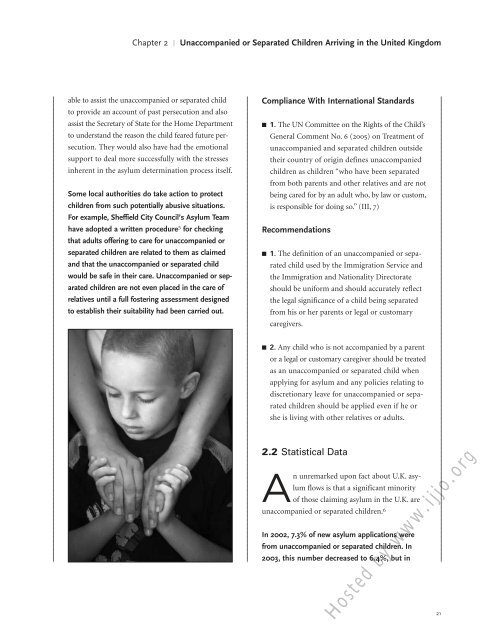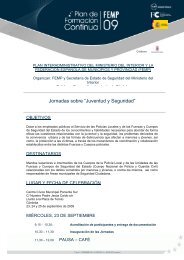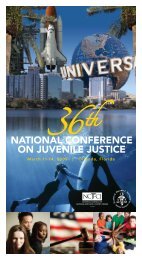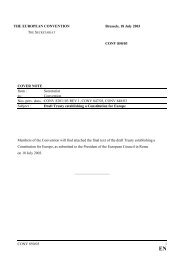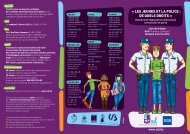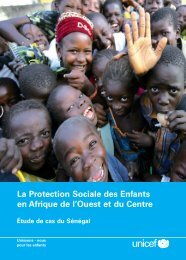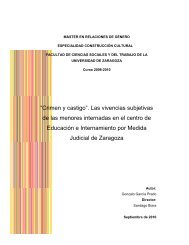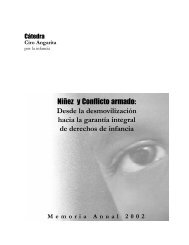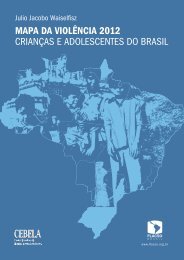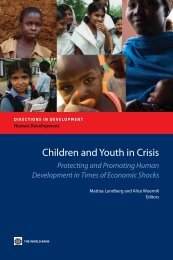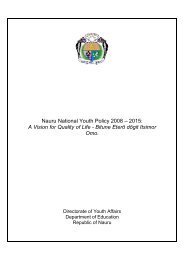Hosted by www.ijjo.org
Hosted by www.ijjo.org
Hosted by www.ijjo.org
Create successful ePaper yourself
Turn your PDF publications into a flip-book with our unique Google optimized e-Paper software.
Chapter 2 | Unaccompanied or Separated Children Arriving in the United Kingdom<br />
able to assist the unaccompanied or separated child<br />
to provide an account of past persecution and also<br />
assist the Secretary of State for the Home Department<br />
to understand the reason the child feared future persecution.<br />
They would also have had the emotional<br />
support to deal more successfully with the stresses<br />
inherent in the asylum determination process itself.<br />
Some local authorities do take action to protect<br />
children from such potentially abusive situations.<br />
For example, Sheffield City Council’s Asylum Team<br />
have adopted a written procedure 5 for checking<br />
that adults offering to care for unaccompanied or<br />
separated children are related to them as claimed<br />
and that the unaccompanied or separated child<br />
would be safe in their care. Unaccompanied or separated<br />
children are not even placed in the care of<br />
relatives until a full fostering assessment designed<br />
to establish their suitability had been carried out.<br />
Compliance With International Standards<br />
■ 1. The UN Committee on the Rights of the Child’s<br />
General Comment No. 6 (2005) on Treatment of<br />
unaccompanied and separated children outside<br />
their country of origin defines unaccompanied<br />
children as children “who have been separated<br />
from both parents and other relatives and are not<br />
being cared for <strong>by</strong> an adult who, <strong>by</strong> law or custom,<br />
is responsible for doing so.” (III, 7)<br />
Recommendations<br />
■ 1. The definition of an unaccompanied or separated<br />
child used <strong>by</strong> the Immigration Service and<br />
the Immigration and Nationality Directorate<br />
should be uniform and should accurately reflect<br />
the legal significance of a child being separated<br />
from his or her parents or legal or customary<br />
caregivers.<br />
■ 2. Any child who is not accompanied <strong>by</strong> a parent<br />
or a legal or customary caregiver should be treated<br />
as an unaccompanied or separated child when<br />
applying for asylum and any policies relating to<br />
discretionary leave for unaccompanied or separated<br />
children should be applied even if he or<br />
she is living with other relatives or adults.<br />
2.2 Statistical Data<br />
An unremarked upon fact about U.K. asylum<br />
flows is that a significant minority<br />
of those claiming asylum in the U.K. are<br />
unaccompanied or separated children. 6<br />
In 2002, 7.3% of new asylum applications were<br />
from unaccompanied or separated children. In<br />
2003, this number decreased to 6.4%, but in<br />
<strong>Hosted</strong> <strong>by</strong> <strong>www</strong>.<strong>ijjo</strong>.<strong>org</strong><br />
21


